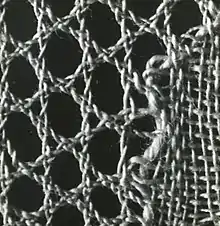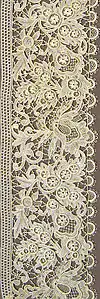 Point de Paris ground in Flemish lace | |
| Type | Lace |
|---|---|
| Production method | Bobbin lace |
| Production process | Craft production |
| Place of origin | Paris, France |
| Introduced | 18th century |

Example of Point de Paris lace from a 1904 text
_-_Lace-Bobbin_Lace_-_MoMu_Antwerp.jpg.webp)
Black silk sample from the Fashion Museum of Antwerp

Detail Paris lace, 18th century
Point de Paris is a French bobbin lace of the 18th century, with slender trailing designs in a point de Paris ground. It was a simple lace, and did not compete with those of Flanders. It was revived in the late 19th century for trimming lingerie and 'fancy linen'.[1]
Point de Paris ground is used in other lace styles as well. It has many other names:
- six-point star - from the shape
- fond chant - it formed the ground of 19th-century Chantilly lace)
- fond double
- Kat stitch - there was a tradition that Catherine of Aragorn started the tradition of Bedfordshire lace
- French ground - it was used in 18th century French peasant lace
- wire ground - the intertwining of the threads looks like a wire mesh
It is also found in Antwerp lace, Chantilly lace and Bucks Point.[2]
References
Wikimedia Commons has media related to Point de Paris.
- ↑ Goldenberg, Samuel L. (1904). Lace: Its Origin and History.
- ↑ Pat Earnshaw (1984). A Dictionary of Lace. Shire Publications. ISBN 0-85263-700-4.
This article is issued from Wikipedia. The text is licensed under Creative Commons - Attribution - Sharealike. Additional terms may apply for the media files.
